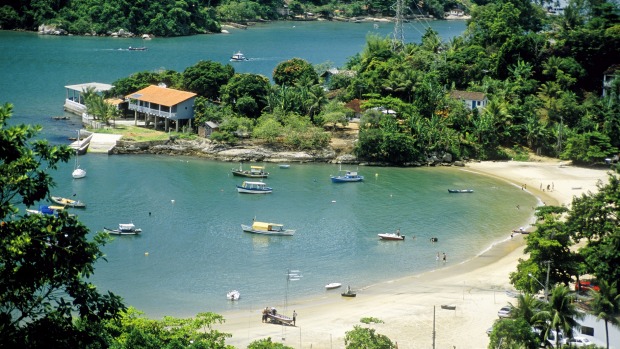
They say Paraty is falling down, but I say the old girl's got a few good years in her yet. She's copped her fair share of rough treatment these past 348 years: countless floods, the mightiest storms, pirate attacks... They don't make old Portuguese fishing towns like they used to; little wonder UNESCO awarded her world heritage listing. When the moon's full, the Atlantic creeps slowly up her ancient cobblestone streets, though each time it looks like Paraty might go under, the ocean bids a swift retreat, leaving a bracken water mark across the walls of her historic houses – a permanent reminder of its hold over the town. Sometimes at night, under the soft light of its historic lamp posts and beneath all those blinking Brazilian stars, she can look a little like Venice, as locals paddle about her streets in old boats.
With all that water about, you can bet she can get on the nose: salty and just a little bit fishy. But I think the waft's endearing, she'd be too pretty otherwise, what with all the summer flowers and flamboyant trees and bougainvillea vines that creep at you as walk, and the ancient coral walls of the old town painted every shade of blue, yellow, crimson, green, mauve and any other colour you might possibly imagine.
Paraty is home to a plethora of trendy cafes, restaurants, bars and art galleries frequented by visitors from across the globe, but she still seems to be the antidote to the frenetic pace – and occasional madness – of Rio.
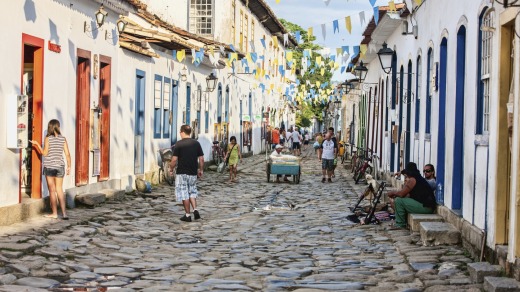
I made a hasty retreat from the late night bars of Rio's world-revered Lapa party district, seeking peace and quiet somewhere on Brazil's ample coastline. Once the claustrophobic cluster of Rio's suburbs were well-behind me, development dwindled almost altogether, replaced with plunging mountains thick with Atlantic rainforest in the national park, Parque da Serra da Bocaina. On the other side of the road I hugged the coastline, gazing out across dozens of tropical islands in the Bay Of Ilha Grande that stretches down to Paraty. Men fished from the bridges I crossed, villages were small and deathly quiet, and seemed more full of chickens than much else. At one point I had to stop altogether as an old man made his way along the roadway on an unsaddled horse. And then when the forest encroached the road entirely, I saw the turn-off to Paraty.
It's lunchtime as I walk into the historic old town, the waft of seafood grilling fills my nostrils and reminds me I haven't eaten since last night. There's wooden chairs sprawled across the uneven cobblestones (there's no cars allowed in here – good luck to anyone attempting to drive across these irregular boulders) and frosty glasses of Brazilian beer being handed out as a busker strums an old classical guitar nearby. All around me people escape the midday sun in meandering green parks and under mango and flamboyant trees as horses trot up the cobblestones and kids with too much energy and too little sense play games of sweaty football. Old man's beard and Spanish moss creeps down from 300-year-old buildings in the old square lending the area a Savannah-like ghostliness. To the right of me the jungle weaves its way up and down the mountains, untethered and undeveloped, while to my left, Paraty Bay meanders out to scores of offshore islands, flanked by old fishing boats and opulent modern cruisers. While there's nowhere to swim here at Paraty itself, the region is home to some of Brazil's finest beaches. They're easily accessible, too; all it takes is a hike through forest or a journey by boat to one of more than 200 empty, isolated bays.
Next morning I climb aboard an old cruiser that traverses Paraty Bay. There's 65 islands in the marine park beside Paraty that are only accessible by boat. Most islands here are entirely uninhabited; the only homes built have no electricity or town water, and rely instead on solar power, generators and water tanks. Little tug boats chuff up and down and across mirrored dark blue water, past beaches lined with coconut trees and jungles thick with long-tailed monkeys and exotic birds such as toucans. There's no hotels here, just old forts and the holiday homes of some of Brazil's most affluent families. I loll in the sun on the boat's open top floor, watching turtles splash, stopping to swim at deserted beaches along the way. For lunch we pull into an old beaten-down dock built across volcanic boulders, then trudge up to an old farmhouse restaurant powered by a rickety, old diesel generator. Inside a centuries-old kitchen, locals prepare a feast of crab and fish and serve it up on an old verandah that looks out across the sea.
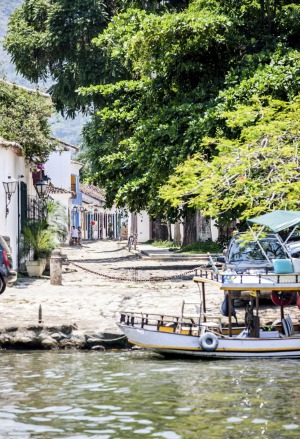
In the evening I return to Paraty, and wander her streets as the sun fades out and the town reaches its crescendo – mellow as that is, outside of the busy summer season. Guitarists strum by the square, visitors dine al fresco, music seeps from every bar and cafe, and arts and crafts stores stay open for late night shoppers. A lightning storm charges the night air with electricity, and a sudden downpour leaves the cobblestones muddy and slippery. But it passes as swiftly as it came, replaced by a billion stars, which I watch through the magnolia trees by the shoreline, keeping my eye on the tide as it advances up towards the cobblestones.
Locals will tell you that no visit to Paraty is complete without a visit to the infamous hippie community of Trindade, 40 minutes further south. Trindade became an alternative lifestyle hotspot in the 1970s when new arrivals claimed UFOs regularly visited their 'magic land' by night. It was secluded then, an idyllic community beside some of Brazil's prettiest beaches, but today the only thing that's changed is the bitumen road in. As I drive in, perfect waves break across Pontal do Cepilho, reggae music drifts from beachside bars along with the earthy, unmistakable waft of ganja. Travellers recline in hammocks threaded between coconut trees looking out across wide sandy bays fringed by forest. I walk past Brazil's beautiful people sipping smoothies, (are they casting a Calvin Klein commercial?) past mango trees bulging with ripe fruit as I make my way along one perfect bay after another. Eventually, after a meander through the forest, I stumble upon the fabled Caixadaco – a natural pool in the sea filled with colourful fish and coral surrounded by smoothed-out volcanic rock.
Trindade and Paraty lie just four hours or so south of Rio, but being here feels more like a bigger journey into Brazil's colonial history. And as I head back up to the bright lights of Rio, watching jutting peninsulas of untouched forest and deserted islands give way to the urban chaos of a city of 12 million, Paraty might well have slipped right back into the sea: just a memory now of how Brazil used to be.
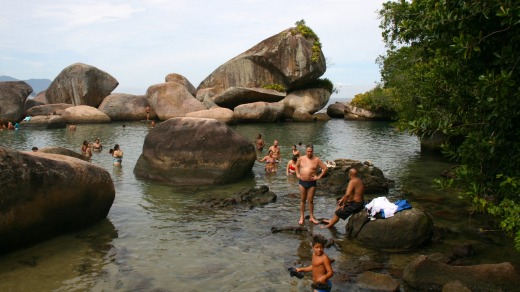
visitbrasil.com
LAN operates seven one-stop flights weekly from Sydney to Santiago, Chile, with onward connections to Rio with TAM Airlines; and three direct flights weekly from Sydney to Santiago in codeshare with Qantas. See lan.com.
Adventure World has a range of tailor-made holidays throughout Brazil, including Paraty, or try their Highlights of Brazil package priced from $4372 per person; see adventureworld.com.au.
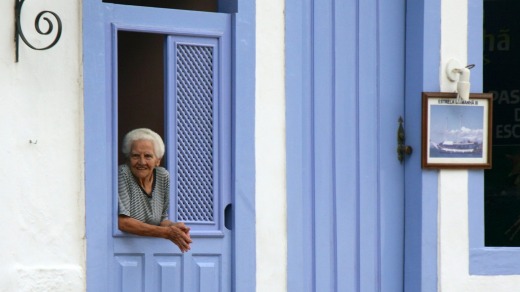
Sleep in a restored colonial property inside the historic old town, from R$860,00 per day, including breakfast; see pousadaliteraria.com.br/home/en.